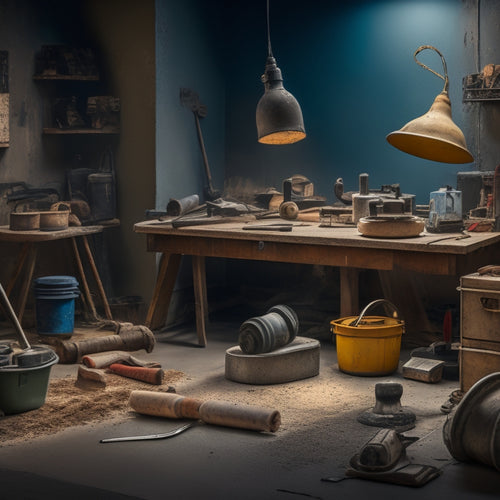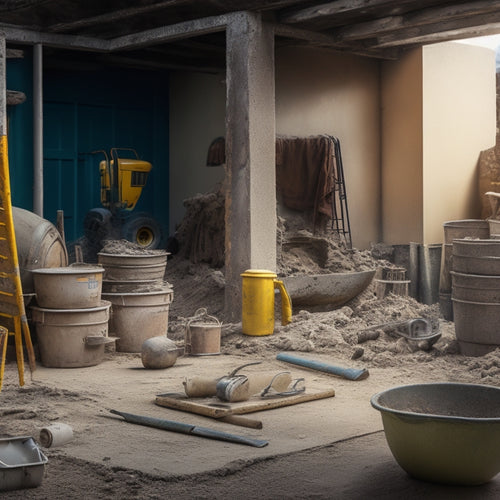
3 Best Essential Tools for DIY Concrete Furniture
Share
You'll need a heavy-duty mixing bucket with a sturdy handle, non-slip bottom, and measurement markings to accurately mix your concrete. A tamper or float trowel is vital for compacting and smoothing the concrete, while a texture mat or stamp adds a personal touch. Don't forget safety gear like heavy-duty gloves, protective eyewear, and waterproof coatings to protect yourself from abrasive concrete and debris. With these must-haves, you'll be well on your way to creating stunning DIY concrete furniture - and there's more to investigate to guarantee your project turns out smooth, strong, and truly unique.
Key Takeaways
- For DIY concrete furniture, a heavy-duty mixing bucket with a sturdy handle and wide mouth is essential for efficient mixing.
- A tamping tool and float trowel are must-haves for compacting and leveling concrete to achieve a smooth finish.
- A set of safety gear, including safety gloves, protective eyewear, and a waterproof coating, is crucial for DIY protection.
- A steel trowel is a versatile tool for applying, smoothing, and finishing intricate areas of concrete furniture.
- A texture mat or stamp can add unique textures and patterns to personalize your DIY concrete furniture creations.
Heavy-Duty Mixing Bucket Essentials
Mixing concrete is a messy business, and having the right bucket for the job is essential. You'll be working with heavy, thick mixtures that can be difficult to handle, so you need a bucket that can withstand the task.
Look for a heavy-duty bucket made from durable materials like steel or thick plastic. The size of your bucket will depend on the size of your project, but a good rule of thumb is to have a bucket that can hold at least 2-3 times the volume of your concrete mixture.
When it comes to mixing techniques, you'll want a bucket with a sturdy handle and a wide mouth to make it easy to mix and scrape the sides. A bucket with a non-slip bottom is also a must, as it'll prevent the bucket from slipping around while you're mixing.
Consider a bucket with measurement markings to help you accurately mix your concrete. With the right bucket, you'll be able to focus on perfecting your mixing techniques and creating beautiful, sturdy concrete furniture.
Concrete Finishing Tool Must-Haves
Your concrete work of art is taking shape, and now it's time to add the finishing touches.
This is where the magic happens, and your piece evolves from a rough, unfinished slab to a stunning work of art.
To achieve this, you'll need the right concrete finishing tools to smooth, texture, and perfect your creation.
Here are the must-haves for your concrete finishing toolkit:
-
Tamping tool: A sturdy, flat tool for compacting and leveling concrete, ensuring a smooth finish.
-
Float trowel: A long, flat trowel for applying and smoothing out concrete, perfect for creating a smooth, even surface.
-
Texture mat or stamp: For adding unique textures and patterns to your concrete, giving it a personalized touch.
-
Edger: A handheld tool for creating clean, defined edges and corners, adding a professional finish to your piece.
-
Steel trowel: A versatile tool for applying, smoothing, and finishing concrete, ideal for small, intricate areas.
Safety Gear for DIY Protection
Concrete work can be hazardous, and a single misstep can lead to injuries or damage. As you engage in DIY concrete furniture projects, it's important to prioritize your safety above all else. You'll need the right gear to protect yourself from the harsh materials and processes involved.
First and foremost, invest in a pair of heavy-duty safety gloves. These will shield your hands from abrasive concrete, harsh chemicals, and sharp objects. Look for gloves with a waterproof coating and reinforced palms to guarantee maximum protection.
You'll be handling heavy concrete pieces, so it's critical to have grip and dexterity without compromising safety.
Next, don't forget protective eyewear. Concrete dust and debris can easily damage your eyes, so you'll need goggles or safety glasses with a strong lens. Make sure they fit snugly and have a secure strap to prevent them from slipping off during work.
With these necessary safety gear in place, you can focus on creating stunning concrete furniture pieces without worrying about your well-being. Remember, safety always comes first, so don't skimp on these important tools.
Frequently Asked Questions
Can I Use Regular Cement for DIY Concrete Furniture Projects?
You can use regular cement for DIY concrete furniture, but you'll need to perfect your mixing techniques and consider reinforcement options like fiber mesh or rebar to guarantee structural integrity and durability.
How Do I Achieve a Smooth, Glossy Finish on Concrete?
You're probably thinking rugged, industrial concrete, but with the right polishing techniques, you can achieve a high-gloss finish. Apply a sealant, like polyurethane or wax, and buff it out - the result is a stunning, glass-like sheen that's almost impossible to believe it's concrete!
What Is the Ideal Temperature for Curing Concrete?
You'll want to maintain an ideal curing temperature between 65°F to 75°F (18°C to 24°C) to guarantee proper hydration, as temperature effects can greatly impact concrete's strength and durability, so monitor and adjust as needed.
Can I Add Color to My Concrete Mixture for Unique Designs?
You can add color to your concrete mixture using color pigments or try staining techniques later. For pigments, mix 1-5% of the pigment weight with the cement weight, and for staining, apply acid-based or water-based stains after the concrete is cured.
How Long Does It Take for Concrete to Fully Cure and Harden?
You'll wait 24 to 48 hours for initial setting, but concrete takes 28 days to fully cure and harden, depending on curing time and moisture control - so be patient and maintain ideal conditions for a strong, durable finish.
Conclusion
You've made it to the end of this DIY concrete furniture adventure! With the right tools, you're ready to create stunning pieces for your home. Did you know that the global concrete furniture market is expected to reach $1.4 billion by 2025? That's a lot of concrete creations! Now, get mixing, molding, and shaping your way to becoming a part of this growing trend. Remember, with the right essentials, safety gear, and finishing tools, your DIY concrete furniture will be the talk of the town.
Related Posts
-

Top Concrete Resurfacing Tools for a Pro Finish
When it comes to achieving a professional finish in concrete resurfacing projects, you require the right set of speci...
-

Top Mixing Tools for DIY Concrete Block Laying
When it comes to DIY concrete block laying, the right mixing tools are vital for a strong and durable structure. You'...
-

What Tools Are Needed for Concrete Wall Foundations
You'll need a thorough array of tools and equipment to construct a concrete wall foundation that meets structural int...


